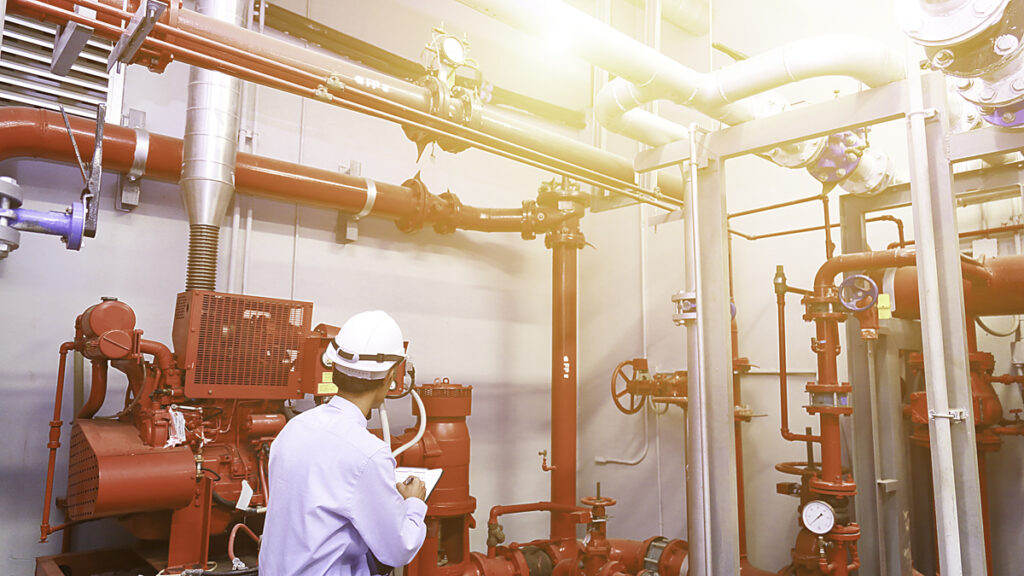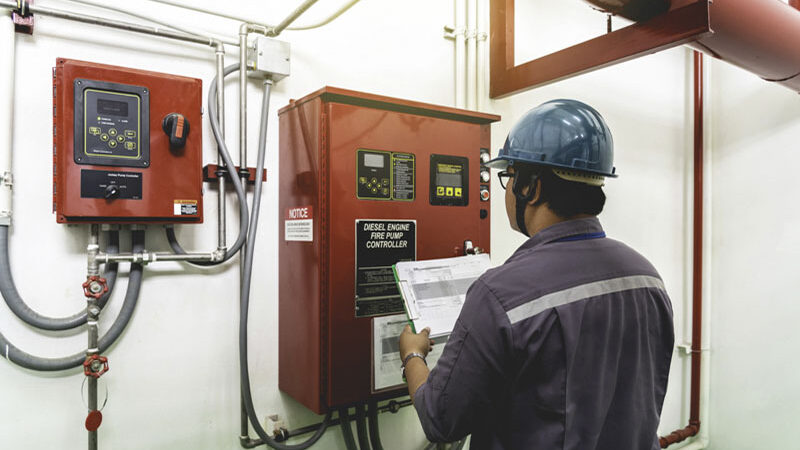Your business’s fire protection system is one of the most valuable assets your company has in saving lives, protecting property and sparing your products. These systems were specifically designed to custom fit your type, size and shape property. And although these systems sit idly by, they must be maintained, inspected and tested to ensure that when you need them most in the time of an emergency, that they are fully functioning and ready to perform.

Inspection guidelines:
Depending on the type of systems you have installed and the requirements set forth by NFPA , IFC, your insurance carrier, joint commission and local AHJ (Authority Having Jurisdiction), these inspections will be one of several frequency types:
• Annual
• Semiannual
• Quarterly
• Bimonthly
• Monthly
• Weekly
• 3rd Year (Dry Systems)
• 5th Year (Pipe Internals)
• 6year & 12year (Extinguishers)
A visual inspection is conducted to identify any physical damages as well as a functional test to ensure proper operation of essential equipment. The inspector onsite will adhere to a checklist to ensure that all systems are working in accordance to these standards and guidelines set forth by the following standards:
• NFPA 25: Standard for the Inspection Testing & Maintenance of Water-Based Fire Protection Systems
• NFPA 72: National Fire Alarm and Signaling Code
• NFPA 10: Standard for Portable Fire Extinguishers
• Joint Commission
• Local Township forms established by AHJ
What to expect:
Prior to our inspection day, any tenants and building employees within these the buildings should be notified of our scheduled testing so they are aware we will be in the building. When the inspectors arrive at your facility, they will notify you of their name, the company they represent and the type of inspections they will be performing that day. At this time, if your fire alarm is monitored through Oliver Fire Protection & Security, you may call out the system through our central station, placing the system on test. This will ensure that as signals are sent from devices to the fire alarm panel, that the fire department is aware of our testing and will not be dispatched. If your monitoring is performed with another company, you will need to have the account information available and you will need to call out the systems for our inspectors.

Fire Sprinkler Inspections: Your inspectors will need access to any and all spaces in your facility that contain fire sprinkler equipment, fire sprinkler piping, fire pumps, backflows (or pressure reducing valves), standpipes and risers, drains both inside and outside of building, fire department connections, and all areas that contain fire sprinklers. If you have backflows or valves in an outside pit(vault), the pit should be unlocked, accessible and any standing water drained out prior to our arrival (extra costs may be incurred if the pit will need to pump out as this will add additional time to the inspection process). Fire hydrants should be accessible and, if possible, a 10’clearance established in order to discharge water freely.

Fire Alarm Inspections: Your fire alarm inspectors will need access to any and all spaces in your facility that contain fire alarm equipment, fire alarm control panels, annunciators, initiating devices (i.e. smoke detectors, heat detectors, duct detectors, flame detectors, manual pull stations, waterflow switches, tamper switches, pressure switches, etc), signaling devices (i.e. strobe lights and audible horns, etc) and any other additional equipment that is part of your fire alarm systems. Duct detectors should be labelled at ceiling level and accessible to be tested properly. If you are receiving emergency light inspections, electrical panels should indicate which switch is dedicated to these lights in order to effectively test. In order to complete the fire alarm testing, we will need to “ring the bells” and set off the audible alarms to be sure they are operational and working within decibel range.

Security Testing: The inspector will be arming the alarm system in test mode and testing each sensing device (door contacts, motions, etc) one at a time to confirm that an alarm is triggered. If there are glass break detectors, a glass break tester will be used. They will also confirm with the monitoring company that they are receiving the alarm signals on their end as well.
Fire Extinguisher Inspections: Each fire extinguisher in the facility should be visible and accessible to physically test and tag.
After Inspection is complete: Once all systems and devices have been inspected, tested and tagged, our inspectors will let you know of our completion and that your central station monitoring can be placed back in active service. A report will be completed and turned into our office for final review and then submitted to the contact on file. If your inspection was completed with no deficiencies found, you should keep the copy of the passed inspection for your records and turn over to proper AHJs for their review.
Deficiencies: Our inspectors will review with you at the completion of the inspection whether any deficiencies were found on your systems. Should there be any deficiencies that would impair the proper operation of your life safety systems, the inspector will then send a copy of the report to our service team who will offer a proposal in order to remedy any deficiencies found.
Should you have any questions about the inspection, testing and maintenance process, please call our office and ask to speak to inspection representative who would be happy to discuss this process further.

